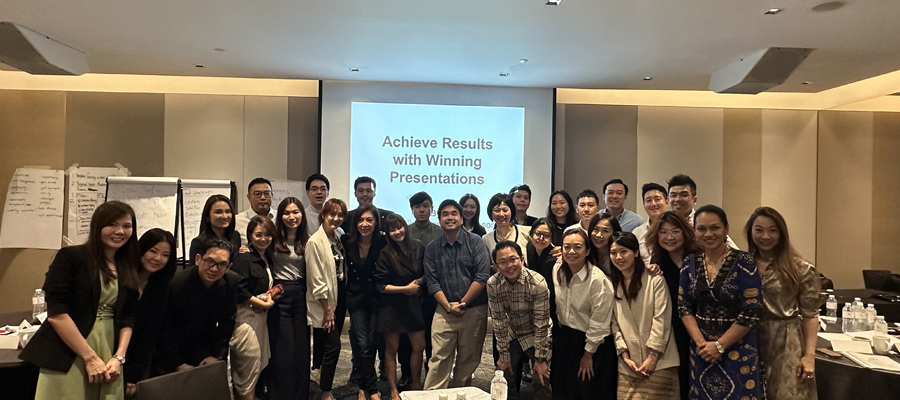
ACHIEVE RESULTS WITH WINNING PRESENTATIONS
At this two-day seminar, you'll learn how to present your ideas with conviction, control and poise-and without fear. You'll gain the specific skills and direction you need to become comfortable with your own presentation style. And you'll receive expert advice on how to handle especially challenging situations. Most importantly, you'll learn how to present by presenting
OBJECTIVES
- Tailor your presentation to your audience.
- Creating winning presentations that captures audience’s attention and create audience buy-in.
- Use relaxation techniques to overcome nervousness.
- Learn how to use body language, movements, clarity of speech and pronunciation of words.
- Project your voice and use pauses to dramatize your point.
- Preparing presentation materials—Wow the audience with your slides
- Expertly handle difficult questions and situations.
OUTLINE
Balancing Verbal and Nonverbal Messages
- Explain the need to balance style and substance.
- Identify the importance of nonverbal (visual and vocal) messages.
- Receive feedback on the nonverbal messages you send.
- Practice nonverbal impact skills to reduce nervousness and to engage the attention of your listeners.
- Demonstrate how to make your content clearer and more memorable by incorporating anecdotes, analogies, examples, and quotes in your presentation.
- Demonstrate how to use audience participation techniques.
Developing and Organizing Presentation Content
- Set presentation parameters.
- Create an audience profile using the DISC psychometric tool.
- Tap into what you already know.
- Identify what you need to find out.
- Structure your information.
- Demonstrate how to condense the speech outline into notes you can speak from.
- Presentation management techniques
- Presentation delivery techniques—Persuasive approach, IMPACT model, MAGIC technique, PREP method and ice-breakers.
Preparing to Give the Presentation
- Explain the benefits of rehearsing, adhering to time frame, and speaking from notes.
- Demonstrate how to reduce sress and speaker's anxiety.
Using Visual Aids and Support Materials
- Describe the purpose of visual aids and support materials.
- Distinguish among visual aids, speaker's notes, and audience handouts.
- Identify tips for effective composition of visual content.
- Describe the criteria for selection among the many types of visual aid media.
- Demonstrate guidelines for interacting with visual aids and managing handouts.
Handling Questions from the Audience
- Explain the importance of the question and qnswer session.
- Demonstrate how to respond professionally to questions from the audience.
DURATION
Two Days
Respond Intelligently Under Pressure and Challenging Situations: Improve Impromptu Communication On The Spot
In today’s fast paced working environment, we are constantly challenged and put under pressure to think on our feet. Regardless of your roles and responsibilities, the ability to think quickly and give a clear and appropriate response will help you take charge of situations and demonstrate confidence and competence.
OBJECTIVES
- Tailor content to different audience types.
- Capture audience’s attention and buy-in.
- Use relaxation techniques to overcome nervousness
- Learn how to use body language, movements, clarity of speech and pronunciation of words.
- Project voice and use pauses to dramatize points.
- Expertly handle difficult questions and situations.
OUTLINE
Overcoming Anxiety
- Building speaking confidence and poise.
- Understanding perception vs. reality when speaking to people.
- Tips and strategies to overcome “stage-fright”.
- Demonstrate how to reduce stress and anxiety.
Vocal and Visual Elements
- Identify the importance of visual and vocal messages.
- Generating visual energy for more impact.
- Body language tips as an engagement tool—do’s and don't’s.
- Importance of vocal engagement—articulation, filler sounds, breaking away from monotonous delivery etc.
- Sounding more engaging when delivering dry or technical content.
Developing and Organizing Content
- Impromptu message templates to better structure responses while thinking on you feet — Icebreakers, persuasive approach, IMPACT model, MAGIC technique, PREP method, etc. (Highly useful and applicable techniques when faced with time constraints and pressure)
- Using transitions to help connect one thought to another.
- Demonstrate how to make your content clearer and more memorable by incorporating anecdotes, analogies, examples, and quotes in your sharing.
- Practice session.
Handling Challenging Questions
- Thinking on your feet and being prepared to take questions; maintaining composure.
- Ready-made remarks and closing.
- Handling open and closed ended questions.
- Reframing techniques.
- Regaining control of the Q & A session.
Review and Conclusion of Day’s Learning
DURATION
One Day
